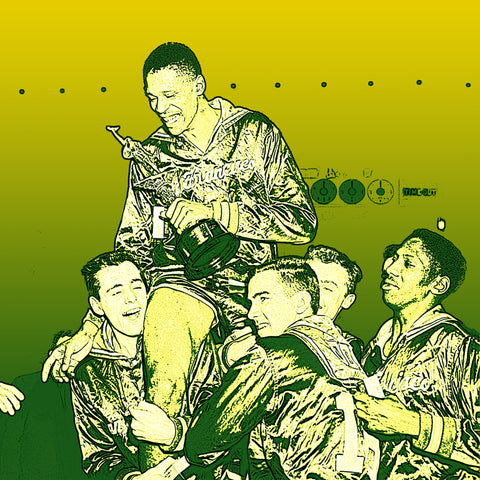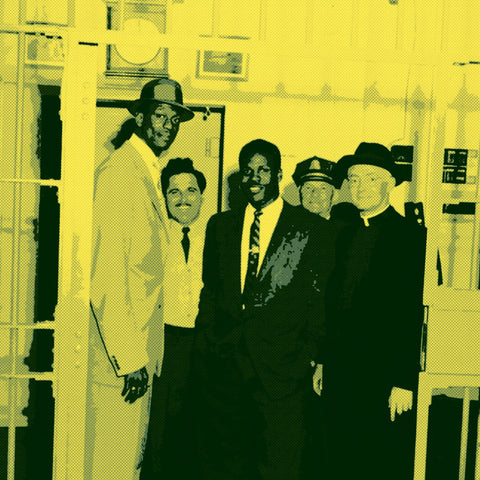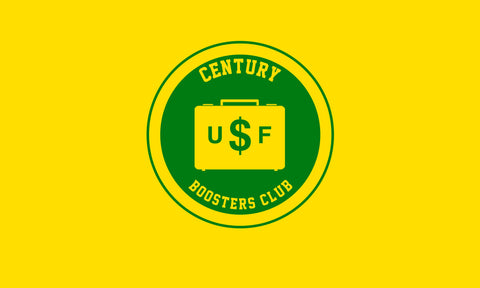
For more than 30 years, the death penalty has robbed the University of San Francisco of Basketball excellence. Religious universities have long had a tradition of paying for players, this tradition was not wasted at San Francisco. The history of USF basketball is littered with achievement and tradition. A program that broke social ground and developed one of the greatest basketball players of all time. The list of alumni that went on to the pros, features Bill Russell, K.C. Jones, Bill Cartwright, Phil Smith, Erwin Mueller, Kevin Restani and Quintin Dailey. Before Bill Russell stared for the Boston Celtics, he was a two time National Champion at the University of San Francisco. Up until 1982, USF was one of the most high profile basketball programs on the West coast. Perennially ranked in the top 20, the team had the distinction of being a major program in a mid major conference (think Gonzaga today). Currently, the schools basketball program has been in a free fall.
The glory days started with the 1946 hire of Roundball legend Pete Newell. The head coach brought instant success and winning culture to the program. During the 1949 season he led the Dons to a NIT championship (at a time in which the NIT was comparable to the NCAA tournament).

Phil Woolpert was hired as Newell’s successor in 1950, he was ultimately very successful with an all time record of 153-73. The coach developed a reputation for recruiting mostly bay area players. Woolpert’s most important move, came in the recruitment of a largely unknown center out of McClymonds High School in Oakland. USF was the only major university to offer Bill Russell a scholarship. Although his skills and fundamentals were raw, he showed tremendous promise on defense. During the 1954 season, Woolpert became the first major college basketball coach to start three African American players. The coach was far beyond his time in terms of race relationship and social acceptance.
Bill Russell and KC Jones are easily the best defensive college duo of all time. The two were selected to multiple All-American teams and led the Dons to back to back titles. During their championship runs in 1955 and 1956 the Don’s won their 9 tournament games by a total of 135 points (only one team got within 10 points). The team was all world defensively and would routinely hold teams below 40 points. UCLA legend John Wooden commented that Russell was the “Greatest defensive man I’ve ever seen”. During his career at USF the center averaged 20.7 points and 20.3 rebounds per game. While K.C. Jones averaged 10 points and 5 boards. Both were named All-Americans in 1956, before leading the NBA’s Boston Celtics to 11 championships in 13 seasons.
The Don’s tradition and excellence served as a pillar in the community. Perhaps nothing symbolized their importance to the community more than a bizarre trip to the notorious jail Alcatraz after the 1956 season. On the day of the visit, the starting five, Russell, Jones, Hal Perry, Mike Farmer and Carl Boldt received a tour of the entire prison. They even visited some of the worst prisoners housed in Alcatraz, guys like Al “Scareface” Capone, Meyer “Mickey” Cohen and James “Whitey” Bulger.
The outlaw collection of murders, crime bosses, bank robbers and sexual offenders greeted the players with a warmth seldom seen by prisoners. In fact, many of the prisoners listened to the Don’s championship run on the radio. Most of the inmates acted like nervous teenage girls meeting their long time fantasy crush. The Don’s forward Carl Boldt added “The convicts looked at Russell and they were just in awe. They were treated like gods during their visit”. Boldt also added “They all cheered and clapped their hands. They said to Russell, ‘That’s the way to go there, big black brother!’ “They cheered us and they were very happy to have us there.” Convicts fired away with basketball questions and comments.
Civilians were never allowed beyond the visiting room and were only permitted to communicate by phone. The players not only walked through the entire prison, they even ate alongside them. All five starters also ate with one of the most famous Alcatraz prisoners of all time Robert Stroud “The Birdman of Alcatraz”. A diagnosed psychopath with an uncanny knowledge of birds, serving a death sentence for murder.
Mike Farmer was the star returner in 1957, as Jones and Russell went on to the NBA. The forward had an outstanding year on his way to being named West Coast conference player of the year, he led the Dons to their third straight Final 4. In 1958, Farmer improved his individual play and was named a first team All American.
From 58 to 1961 the program was marred in mediocrity. But a glimmer of hope appeared with the hiring of Peter Peletta in 1961. They regained basketball relevancy with stars like Ollie Johnson, Erwin Mueller and Joe Lewis. Johnson was a dominant big that averaged more than 20 points and 16 rebounds for his career. They again reached glory in the 1965 and 1966 season reaching back to back Elite 8s. From 1966 to 1970, USF struggled heavily under head coach Phil Vukicevich compiling a 51 and 51 record.
Phil Smith was one of the most important players in the history of the Dons. The Berkley native was an unknown prospect with no scholarship offers. After graduating from high school a semester early, Smith enrolled in night classes at USF. He was recruited by coach Bob Gaillard, after watching him play pick up games on campus. From 1971 to 1974 the 6-4 Smith continued the tradition of USF developing unknown players and helping them flourish. The great all around guard lead the Dons to consecutive elite eight appearances. Averaging 18 PPG, Smith was named all-West Coast Conference selection all three years of his career. During his senior season he was named an NCAA All-American.

The Dons Century club was made up of elite alumni from the University, they boasted a top notch pay roll. Hookers, booze, drugs, cars, accommodations, free meals and money were all in the mix for the Dons Century Club. The “nonprofit” committed hundreds of thousands of dollars to illegal recruitment of players, paying off family members, and paying for travel. Other alumni within the Century Club were giving players thousands of dollars, paying them for no-show jobs, providing lavish gifts, as well as picking up pricy restaurant and entertainment tabs. The alumni club began heavily involved in the recruitment of basketball talent sometime in the mid 70’s.
The century club was not the only party to blame. The school did their fair share to provide illegal gifts and bonuses to the players. The team continued to receive special academic treatment; many of the players were marginal students at best. There were several incidents of a player threatening another student, only for the complaint to be dismissed by school officials.Tutors also went above and beyond their duty, often completing assignments and tests for the athletes.
When Phil Smith graduated in 1974, USF gained a major commitment in Sacramento native Bill Cartwright. In 1977, led by the 3 time All-American center, the Dons went 29–0 and were regarded as the #1 team in the nation for 6 weeks of the season. Sports Illustrated highlighted the 1977 team with a cover story titled "The Dandy Dons.” Cartwright was the West Coast Conference’s only 3 time winner of the player of the year award. Future pros, Winford Boynes and James Hardy helped Cartwright dominant the opposition from 1975 to 1978.
The NCAA placed the Dons on probation two times in the late 1970s for booster interference and recruiting violations by coaches. In 1979 the NCAA put USF on probation, promising stricter penalties in the future. The NCAA investigation eventually led to the dismissal of a San Francisco head coach, leading San Francisco Chronicle sportswriter Glenn Dickey to call the program "totally out of control.
School president Rev. John Lo Schiavo, let it be known after the second NCAA case was resolved in 1980, that he would shut down the high-profile program if there was any further incident. Besides firing the coach, Schiavo took no steps to prevent the incident from reoccurring.
One of the greatest players in the history of the University, ended up to be its death. Trouble started when Quentin Daily committed to USF during the early 80’s. The dynamic scoring guard from Baltimore was a high profile recruit when he made the surprise commitment to San Francisco. The Don’s won the conference championship all three seasons while Daily was in school. He averaged 22 points as a sophomore while shooting 57 percent. Good enough to be named Player of the Year in the Conference. The next season he put up 25 points per game to go along with 54 percent shooting. Daily was named to an All-American team for his efforts, and again Conference player of the year.
It all climaxed in December 1981, when All-American Dailey was accused of assaulting a female student. During the investigation, Dailey admitted taking a no-show job for $1,000 a month at a business owned by a prominent USF Dons Club booster, while another booster had also paid Dailey $5,000 a month since 1980.
Lo Schiavo claimed, he didn't know that Dailey was suspected of committing rape until a month after the incident occurred. It all seemed very unlikely, due to the fact that the dormitory was right across from his office. Schiavo is ultimately to blame for not being diligent and keeping up with players who he deemed were such a threat to the fabric of the university. The school saw an easy way out and dissolved all responsible from themselves and pointed the finger at the Don’s Booster Club and their student Quintin Daily.
On the cloudy day of July 29, 1982, the hammer dropped. The administration lived up to their promise of strict penalties. The school announced a self imposed Death Penalty, allowing all of its active players to transfer elsewhere. The decision left a one time basketball powerhouse on its knees. Administration decided when they did reinstate the basketball program, it would be done under much stricter academic guidelines.
Oddly enough, the 1982 season also marked the cancellation of the Don’s football program. While it was a division II program, it had a rich history dating back to the 1951 team. The 1951 team was called the greatest team “you've never heard of” producing three future NFL hall of famers. The 1951 team was also the last division 1 football team they put out.
Schiavo was the schools administrator with the end say. The catholic persist was a prep basketball star for Lowell in the 1960s. Schiavo decision and judgement regarding players talking pay seemed to be bias, when that decision was being made by someone who made over 275,000 a year. Upon her visit to San Francisco, Queen Elizabeth II pulled Lo Schiavo aside to ask when he would reinstate the basketball program. Critics have cited that several members of the coaching community backed the decision by Schiavo to kill the program. The two main supporters of the decision by Schiavo were Bobby Knight and Joe Paterno, ill let you do the math.
One has to wonder, if ethics were the top priority, if the University really wanted to put their focus on academics? Changing the school to a division 2 or division 3 affiliation would have been admirable, but the school decided to continue competing in division 1.
Schiavo failed, he failed the community, he failed the players and he failed the students. His seemingly lackadaisical attitude and lack of institutional controlled allowed outside forces to corrupt his university. His biggest failure was to control the influence of the Don’s Century Club, rumors of Schiavo being paid by the Century Club cannot be ignored.
The Athletic director Bill Fusco at the time offered his thoughts "The basketball program hasn't been as strong, but now they can say they run their program with integrity,". Fusco also added "At the time, I didn't agree with the decision. I felt it was really drastic. I still have mixed feelings about it 30 years later”.
The statement by athletic director Bill Fusco, about integrity should be taken with a grain of salt. From 2007 to 2008 notorious rule breaker Eddie Sutton was hired as coach for the Don’s. Although he lasted less than a season his hire should be met with serious speculation.
Since its death penalty in 1982 the Dons have only made one NCAA tournament (1998). The onetime powerful program was brought to its knees by its own administration. The school, students and community all lost dearly in this respect. Things will never be the same. Would the school make the same decision if they knew the schools basketball team would never truly be able to regain its form. No telling how successful the program would be today if the death penalty was never instituted. Does five years of rule breaking constitute a universities sports team to loose the ability to compete?


1 comment
I have information about a usf basketball player who threatened a woman with a knife before raping her in her dormitory room.The usf police and the sf police departments did nothing.